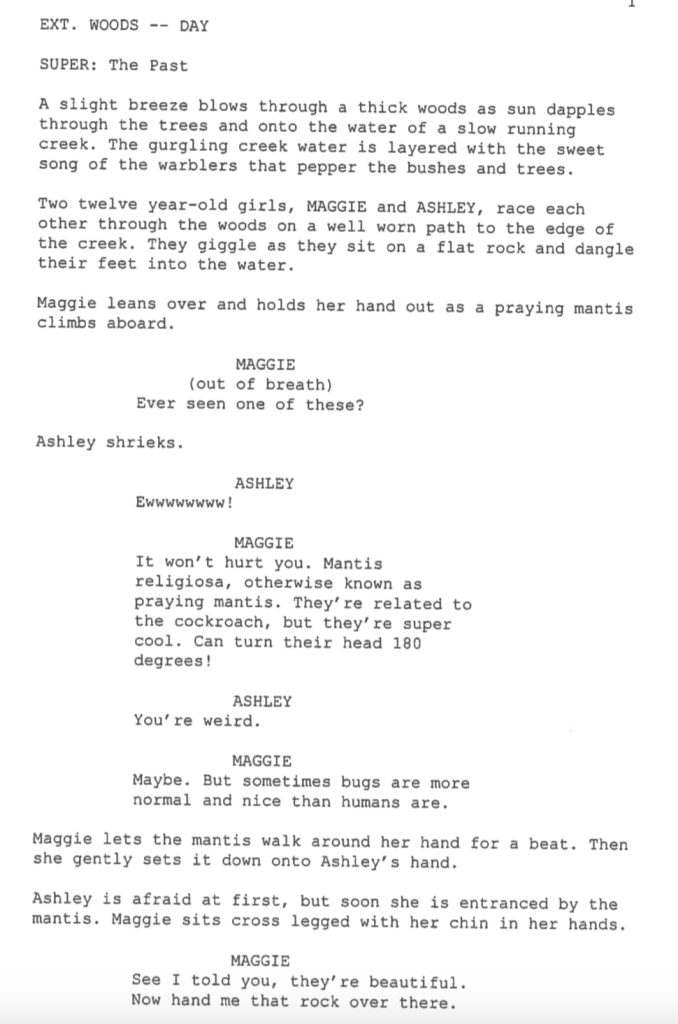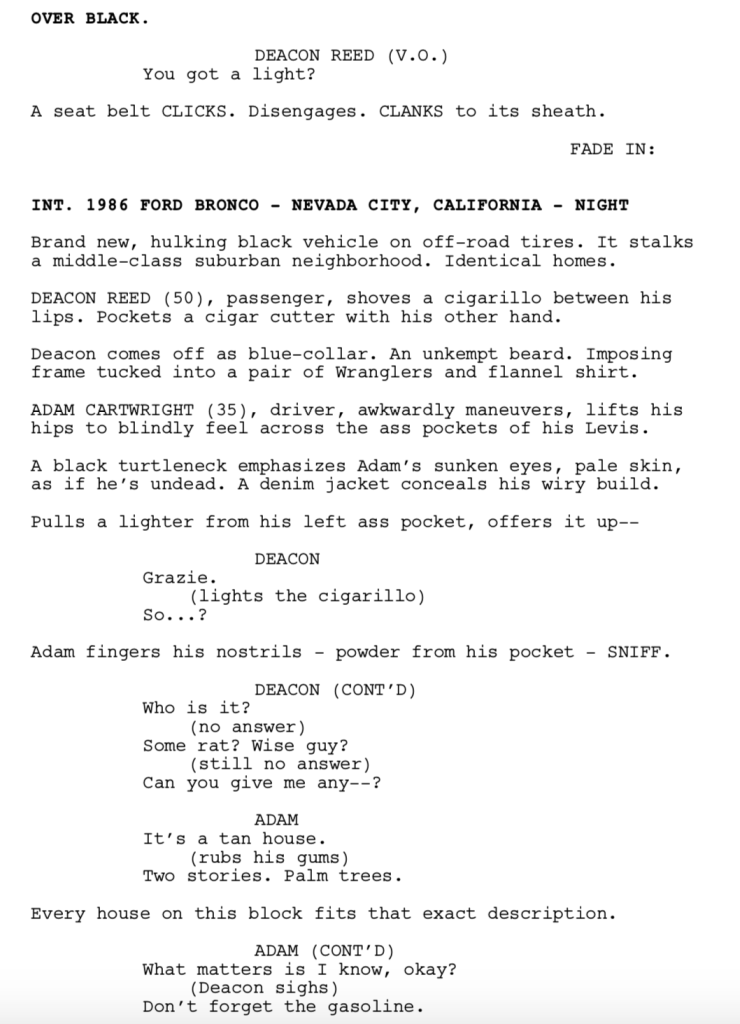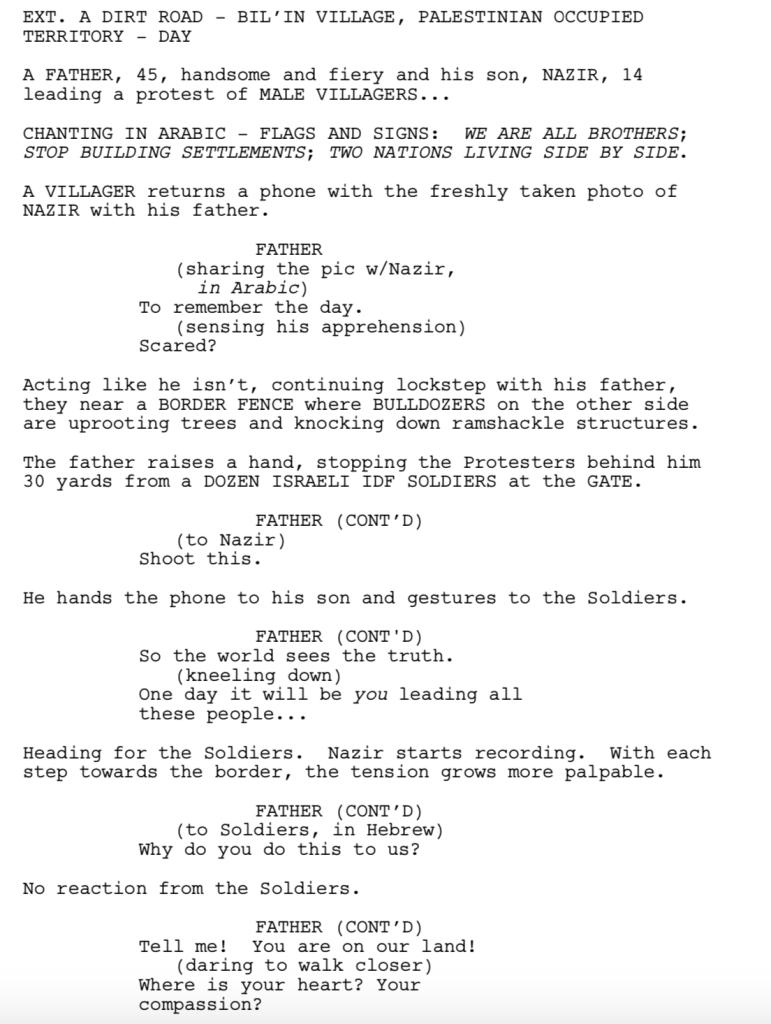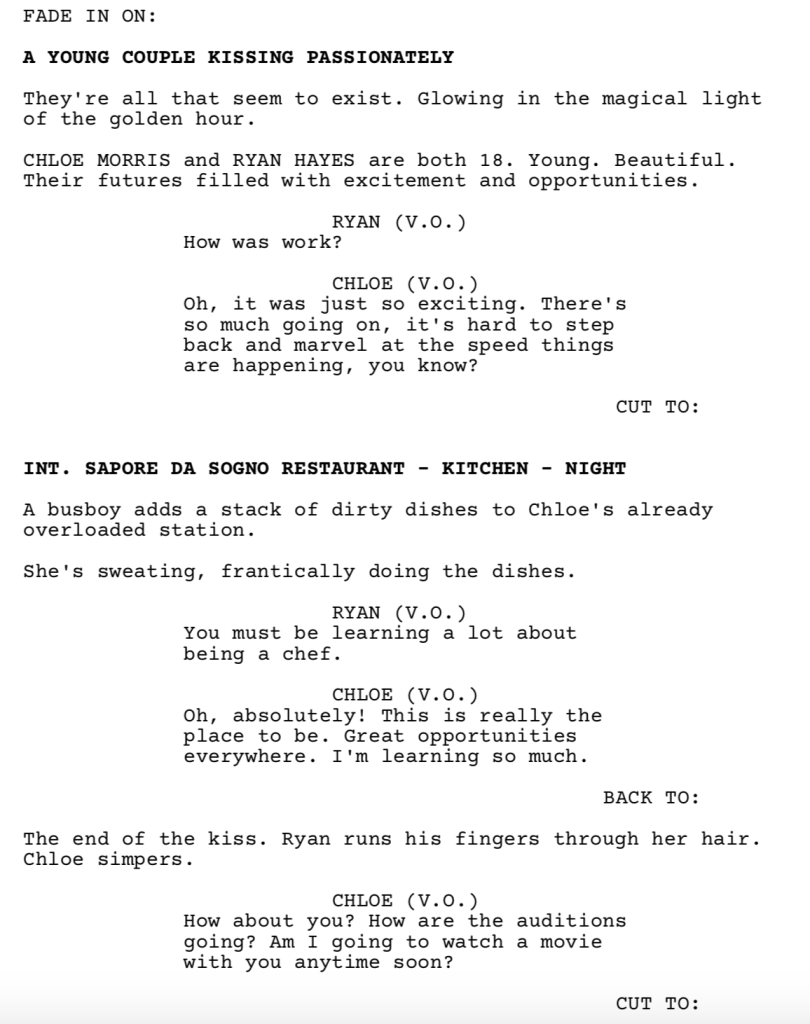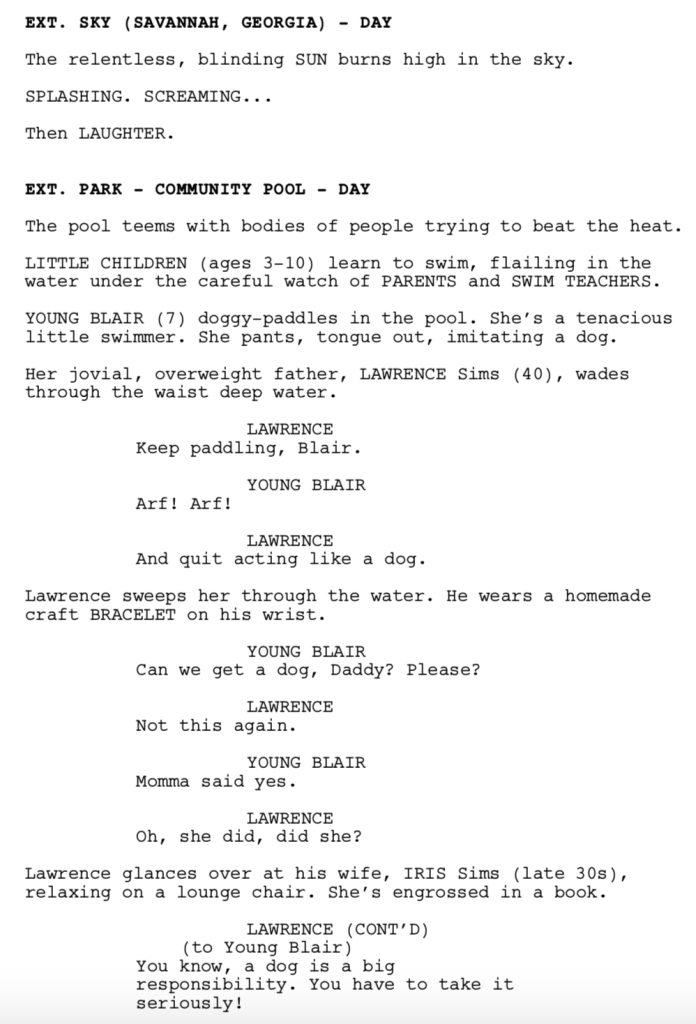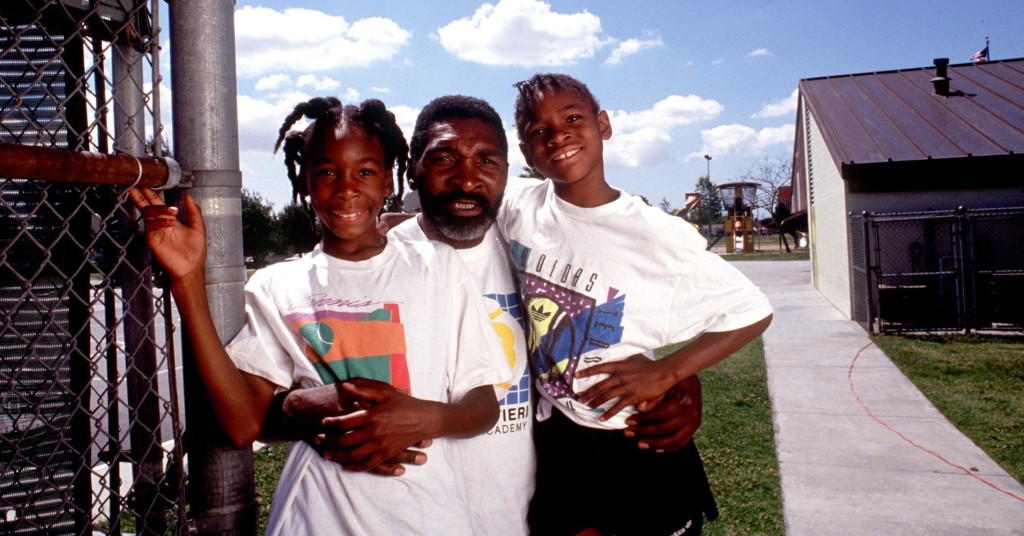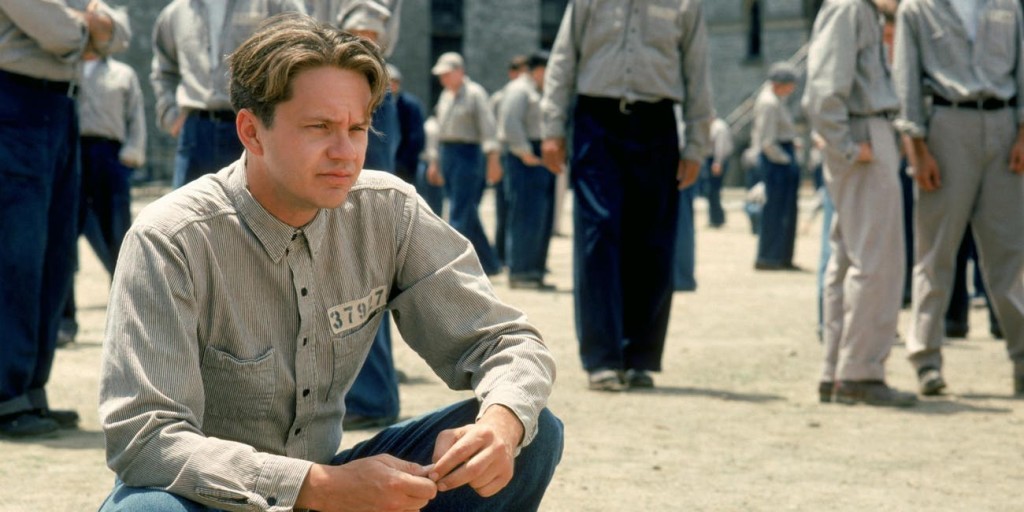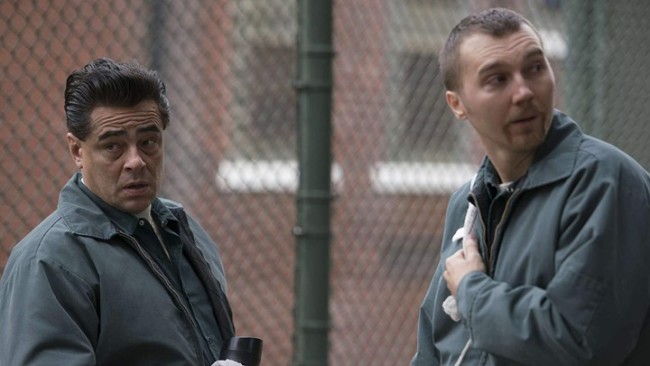It’s a new year. A new 365 days of possibility (well, 361 now). And what better way to break through than being endorsed by your own peers!? It’s the first Amateur Offerings of 2019, a bi-monthly tournament whereby five screenwriters square off against each other in a good old fashioned writing brawl. You, the readers, download and read as much of each script as possible, then vote for your favorite in the comments section. Whoever receives the most votes gets a review next Friday.
If you’d like to submit your own script to compete in a future Amateur Offerings, send a PDF of your script to carsonreeves3@gmail.com with the title, genre, logline, and why you think your script should get a shot.
Good luck to this week’s contestants!
Title: Insectum
Genre: Horror (subgenre: Slasher)
Logline: A group of high school girls and their teacher are taken in by twins with an obsession for insects after they are unexpectedly stranded on the way to an overnight field trip. There, they must fight for their lives as their teacher attempts to atone for a sin from her past.
Why You Should Read: Prom Night. The Prowler. Class Reunion Massacre. Tenebrae. City of the Living Dead. Old school slashers, giallo. Are you someone who wants to see more of a renaissance of these horror subgenres from the 1970s and early 80s, but with a sick feminine twist? We were influenced by these movies, and also wanted to write about people on the fringe…people whose inner secrets and desires and losses drive them in unexpected directions, both positive and negative. Insectum could be produced on a minimum budget, but to maximum effect, creating a unique female-centric slasher. Stephen King says to write the story you want to read. That’s exactly what we’ve done with Insectum.
Title: Rat Bastards
Genre: Crime
Logline: A mob enforcer escorts a nameless corpse to its final resting place with the help of a young recruit, tasked with eliminating the older mobster turned informant once the job’s done.
Why You Should Read: Earlier this year, the news dropped that the “company” I work for is being absorbed by the succubus of children’s programming. It got me thinking of some of my co-workers’ situations… Middle aged and suddenly without work once the guillotine falls. There’s an inherent terror in that idea, situation. And, like every writer, I thought about how I can exploit their impending misfortune for a story.
“RAT BASTARDS” is the product of that mental trek and a simple question – how the fuck would the mob lay you off? Well, they kill you, spoiler alert. At a certain age, that is what being fired/laid off becomes… Murder. Murdering whatever life you had known or future you had planned out. You’re too old to be desirable and too young/poor to retire. This script is my way of exercising that anxiety in a genre vein that hopefully comes off as entertaining.
The script is a smaller addition to the gangster genre; indie in scope and, as it currently exists, something within reach of getting made on the cheap. I like writing that kind of script. I feel like it gives me a fighter’s chance of reaching the screen.
I appreciate all notes, good and bad and everything in-between. Thank you for giving “RAT BASTARDS” the time of day.
Title: No Man’s Land
Genre: Drama
Logline: Disgraced tennis player Izzy Vardi must pause his comeback and move back to his homeland of Israel to take care of his catatonic father after a vicious suicide bombing.
Why You Should Read: There have been movies that involve tennis and there have been movies set in the Middle East, but there has never been a sports drama that looks into the tumultuous Israeli/Palestinian conflict while showcasing the struggle and loneliness that is tennis. I grew up both in Israel and America and played tennis at a high level in college and professional tournaments. The relationship between an athlete and tennis is a cinematic one that I look forward to sharing with readers while also painting a picture of the frustrating standstill happening in my homeland.
Title: Rival Cities
Genre: Adventure/Giant Monster
Logline: A young couple’s dreams to make it in the big city are put on hold when New York City literally stands and crosses the country to pick a fight with Los Angeles.
Why Should You Read: In the January 1st post “2019 is here!!! YAHOOOOOOO!!!”, Carson listed three problems on the way to a good screenplay, which led me to question if Rival Cities is a good screenplay or not. Let’s see. First, effort. Research was a problem, as I couldn’t find any city that has risen from the ground to kick another city’s ass, but that doesn’t mean there was no research, like the countless hours measuring stuff on Google Maps. Then, there’s the hard work in outlining, writing, rewriting. The struggle to find the perfect balance of how serious the story should be. Too serious and no one gets on board with the preposterous premise. Too goofy and people forget it as soon as the story is over. Second, “Is this a movie people would actually pay to see?” Hell yeah! Larger than life? Check! Heavy conflict? Check! Clever? Check, I guess! Ironic? Alanis would check! Taps into the zeitgeist? I don’t know! Controversial? Hardly! Finally, execution. Everyone who reads this not only “gets it,” but also enjoys it. It even got to the second round in the Austin Film Festival screenplay competition, which is a feat for an outrageous popcorn movie like this one. I tell ya, that’s not what a badly executed screenplay looks like. So. Is Rival Cities a good screenplay? I’m too biased to say. So crack it open and find out for yourself.
Title: Blood Hound
Genre: Horror
Logline: Trapped in a strange house, a young woman with a fear of dogs must escape the jaws of a bloodsucking hound and its master.
Why You Should Read: I find phobias fascinating. The crippling impact they can have on a person’s life. I wanted to take that fear to an extreme level. There seems to be room in the horror universe for an update on Cujo (other than a remake), pitting a protagonist against a vicious, bloodthirsty beast. I set out to write something simpler and more contained than my last work with 100x more blood. Hope you enjoy sinking your teeth into this one!
Genre: Biopic
Premise: (from Black List) The true story of Richard Williams, the hard-nosed and uncompromising father of tennis prodigies turned superstars, Venus and Serena Williams.
About: This script finished number 2 on the 2018 Black List with 36 votes. The writer, Zach Baylin, is no stranger to the Black List. Last year he made the list with “Come As You Are,” about a young woman who becomes undone while moderating X-rated content on a social media platform. Before that, Baylin worked in the art department on Stephen Soderbergh’s, “Side Effects.”
Writer: Zach Baylin
Details: 122 pages
Ah, biopics and the Black List. They go together like peanut butter and fried bananas. Why is it that we groan loud enough to trigger the Richter Scale every time we see a biopic on the Black List? Why does the genre inspire such negativity?
Because we operate in an industry that’s becoming less imaginative every year, that’s why. Two decades ago, Hollywood was open to any weird idea you could come up with. In 1998, one of the biggest script successes was a story about a guy who was trapped inside actor John Malkovich’s head. As writers, we celebrate ingenuity. We celebrate imagination and fresh ideas. Biopics are the opposite of that. They take zero brain power to come up with. You find a person and say, “I’m going to write about them.”
Snore.
It’s sort of like a musician covering a famous song. It’s an easy way to get air play. But in the end, it’s something that already existed. All you did was repackage it. This is not to say I bemoan writers who write biopics. You give the customer what he wants. And Hollywood wants biopics. Not to mention, a great character journey can be a transformative experience, which is exactly what I’m hoping for from today’s script, King Richard.
The year is 1988. The setting is Compton, Los Angeles. It’s here where 45 year old Richard Williams is teaching a form of tennis to his two athletic young daughters, Venus (8) and Serena (7). I say a “form” of tennis because Richard’s never actually played tennis before and therefore doesn’t know what he’s doing. He routinely calls out “nice shot” when Venus or Serena launches a ball ten feet over the fence.
But Richard has a plan. How extensive is this plan? Try this on for size: He specifically conceived Venus and Serena so that he could turn them into tennis champions. It isn’t long, however, before Richard realizes that his unique brand of coaching isn’t going to be enough. These girls need professional training, and so Richard starts sending awkward video tapes of himself touting his girls out to every big tennis coach in the country. Three years later, he gets one to bite, Rick Macci, the Florida coach best known for training Jennifer Capriati.
Richard, his daughters, and the rest of the family move to Florida to enlist Venus and Serena in Macci’s program. But then Richard drops a bomb on Macci. “I don’t want them to play any tournaments until they turn pro.” For the uninitiated, every ranked tennis player in history played junior tournaments first. The experience that comes from competition is what allows young players to prepare for the big dogs on the pro tour. But Richard is skeptical of how this pressure will affect his daughters, and opts instead to put them in school for three years while they train. Macci is furious. He’s now being asked to spend the next three years of his life getting paid nothing to train these girls, with the hope that they’ll be ready for the pro tour when they debut.
To Macci’s credit, however, he takes a chance on the sisters. Meanwhile, paradoxically, Richard begins a three year media campaign preparing the sports world for the second and third coming of Jesus. The girls become mysterious legends due to New York Times and Sports Illustrated articles about their practices in Compton, which include dodging drive-by bullets while hitting balls. By the time Venus enters her first tournament, it can be argued that there wasn’t a more hyped sports debut in history. With the world watching, a 14 year old Venus walks out to play the number 58 player in the world. Will Richard’s decades-plus plan pay off? Or will the Williams sisters be yet another product of unsubstantiated hype?
The nice thing about biopics is that they teach screenwriters how to write characters. Because in a biopic, the movie is the character. Richard the Great is a perfect example of how to do this well. I can give you two qualities right off the bat that make him someone you want to root for.
The first is obvious. He’s an underdog. I’ve said this before and I’ll say it again. Underdog characters are some of the best characters to write because they’re impossible to dislike. And the cool thing about Richard the Great is that we get two different levels of underdog. The first is the environment. Tennis stars aren’t made on the streets of the ghetto. So that alone makes you root for him. Also, there aren’t a lot of black tennis players. It’s a predominately white sport. So the Williams family is trying to break into a sport that doesn’t recognize their culture as applicable to its own.
The second quality is that Richard is a fighter. Literally. One of the early storylines is that the gangs don’t like Richard and his daughters practicing on the court. So he gets in fights with them every night so his daughters can keep playing. And after they beat the shit out of him, he fights back. At one point, he takes a shotgun to the park and starts shooting at them. I don’t know if that really happened. But the main note here is that we like characters who fight. We don’t, conversely, respond well to wimps. If you’re ever writing a movie where you have a geeky character who gets bullied, it’s much better to have that character fight back (even if they get beat up) than curl up into a ball and let it happen.
Another thing I liked about this script is that it never went backwards and it never stagnated. Every ten pages, the stakes felt higher than the previous ten pages. The story wasn’t just moving forward. It was getting more exciting as it moved forward. That may seem like an obvious observation but the vast majority of scripts I read do the opposite. They get less interesting as they move on, not more. You really felt the rise of Venus and Serena, and the pressure, in the end, to live up to the hype that Richard had built for them. I mean, when that first tournament – the climax of the script – comes around, I was genuinely nervous for Venus. And you’re talking to someone who watched all five of her Wimbledon title matches. I know the story ends well for her.
The only place where the script falters is in its central conflict. Baylin focuses on Richard’s decision to delay his girls turning pro so that they can get educated and learn to be girls first. He was particularly afraid of them meeting the same fate as Jennifer Capriati (a famous tennis phenom at 12 years old who turned pro too early and subsequently became a drug addict). The three problems with this were that, one, we never saw the girls in school. So we never believed that was truly a priority. Two, during this whole time, Richard was barking to the world that his girls were superstars. If he didn’t want his daughters to experience the pressures of early superstardom, why was he putting more pressure on them than any junior tournament could? And finally, Venus didn’t wait until she was 18 to become a professional. She waited until she was 14. So how much education did she really get?
Despite these issues, this is too good of an underdog story not to like. Biopic or not, King Richard is worth a read.
[ ] What the hell did I just read?
[ ] wasn’t for me
[xx] worth the read
[ ] impressive
[ ] genius
What I learned: Remind the audience early on how impossible the plan is. An easy way to do this is to have another character tell your character how insane the odds are. We get that here, when tennis coach Vic Braden tells Richard that what he’s hoping to do is ridiculous: “It’s like the violin. It takes hours and hours a day, year after year, tens of thousands of dollars in precise, expert instruction just to hold the racket right, and then, even then, even for a family with unlimited financial resources, the chances of achieving the kind of mastery and success you’re talking about — with one kid, let alone two — well, it’s like asking someone to believe you got the next two Mozarts in your house. It’s just very, very unlikely. I’m sorry. That’s just my two cents. Maybe you’ll prove me wrong.”
What I learned 2: An “I’ll Show You” Screenplay. An I’ll Show You Screenplay is when you tell the early years of a real life success story. It’s one big dramatic irony narrative. We all know that Venus and Serena go on to become superstars. So every step of the way, when naysayers are trying to stop them, we’re raising our fists joyfully saying, “I’ll show you!” We can’t wait for the moment when they’re proven wrong since we know for a fact it’s coming.
Save the Cat. The phrase sounds so innocuous and yet it’s become the most popular screenwriting tip in history. More popular than even GSU! For those who don’t know, “saving the cat,” is a term the late Blake Snyder coined that refers to a moment early in the screenplay when your hero does something nice, endearing or helpful to someone or something else. As long as it’s not too generic or too on-the-nose (would we believe that Ethan Hawk would stop running from the bad guys to help a little old woman cross the street?), it’ll make us like your hero. Why has the Save The Cat scene endured for 20+ years? The reason is important so I want you to pay attention. One of the most crucial aspects of making a story work is the reader connecting with the main character. And the easiest ways to solidify that connection is to make them likable. What’s more likable than “saving” someone?
Well the other day I stumbled across one of the best movies ever, The Shawshank Redemption, and I came across a scene that, in retrospect, was the scene that made me fall in love with Andy Dufresne. The reason this particular scene is so important is because Andy Dufresne is considered one of the most likable protagonists in cinema history. After that scene, myself and millions of movie fans liked this guy more than we liked our own friends. So if we can identify what made us fall in love with Andy, we can harness that power to use in our own screenplays. I know all of you are scrambling to figure out which scene I’m talking about. Shawshank has so many good ones, it’s hard to keep track. But before we get to the scene, let’s break down the explanation.
I would argue a more impactful scene than even saving the cat, is a hero’s ability to cleverly out-maneuver the bad guys in the face of adversity. The more clever the character is in the moment, and the more intense the adversity, the better this tool will work. For those of you who’ve read my book, you’ll remember me highlighting one of these scenes. This was before I realized how powerful this scene was so I didn’t give the weight it deserved. But the scene occurred in Terminator 2 at the psychiatric ward when Sarah Connor is running away from the guards. She reaches a locked gate, opens it with her stolen keys, then, as the guards are approaching, reaches back through the bars, inserts the key and then RIPS the top of the key off. When the guards get to the gate, they find that their key is worthless, as the bottom half of Sarah’s key has jammed the lock. This is the epitome of being clever in the face of adversity.
Let’s get back to Shawshank. Now that you have this extra information, do you know what scene I’m referring to? Well, you can watch it right here. Yep, it’s the famous rooftop tarring scene. Now there are a few things going on in this scene but the part I want you to pay attention to is the moment Captain Hadley is running to throw Andy off the roof. This is the highest level of adversity a character can face. His death. Andy then yells out the line that saves him – “Cause if you do trust her, there’s no reason you can’t keep that $35,000.” Captain Hadley stops at the last second, demands an explanation. Andy goes on to inform him of a tax loophole that will allow Hadley to keep his inherited money tax free. After some back and forth, Andy says he’ll even do the paperwork for him, so he won’t have to hire a lawyer. In less than 60 seconds, Andy’s gone from public enemy number 1 to the Captain’s new best friend. You gotta be mighty clever to pull that off. And because Darabont is such a genius, he doubles down! He buttons the scene with a Save The Cat moment – Andy getting beers for his fellow inmates. Is it any wonder, now, why Andy Dufresne is one of the most liked characters ever?
An important distinction I want to make is that being clever is good. Being clever will always make your hero likable. Ferris Bueller was clever. He was always outsmarting everyone. But what turbocharges this tool is being clever in the face of adversity. Real adversity. When we see someone who’s doomed reach into their back pocket and outsmart the bad guys, that’s when the audience feels the warmest and fuzziest. It’s that energy that allows you, the writer, to reach out and join hands with the audience. The both of you are now interlocked as presidents of your hero’s fan club.
Now it’s important to note that the action your hero performs must actually be clever. It has to be something that surprises the audience, something they wouldn’t have thought of themselves. For example, your hero palming a paper clip he later uses to discreetly unlock his handcuffs with won’t do the job. We’ve seen that so many times that we could’ve thought of it ourselves. It must be an act that we wouldn’t have thought of.
Ever wonder why Wesley, from The Princess Bride, is one of the most popular characters of all time? It has a lot to do with William Goldman giving him three scenes IN A ROW where he’s clever in the face of adversity (first the sword fight with Inigo Montoya, second the brawl with Fezzik, and third a duel of wits with Vizzini). One of the reasons The Martian became such a huge book (and later a huge movie) is because Mark Watney is handed a series of obstacles, each of which would ordinarily kill a man, that he cleverly overcomes. First is lack of communication. Next is food. Next he’s critically injured from the air lock explosion. The more we see characters overcome these moments using their intelligence, the more we love them.
So why don’t we see more of these scenes in movies? Because they’re hard to come up with! It’s much easier to save the cat. Have your hero toss a twenty into a homeless man’s cup, follow it with a conversation between the two to show that our hero knows and cares about him, and boom, we’ll like the hero well enough. But that’s child’s play. I can teach a sixth grader to do that. Creating a scenario to show off how clever your hero is is much harder. Which is why, I’d argue, it’s more powerful.
So Carson, if coming up with these scenes is so hard, how do you do it? You do it by identifying your character’s biggest strength. What are they known for? Once you figure that out, you can build a scenario that allows them to show off that strength. Sarah Connor spent a decade preparing to survive. She’s a survivalist. So it would make sense that she’d have a few tricks up her sleeve to outrun pursuers. Andy Dufresne is a tax lawyer. So of course he’s going to know about tax loopholes. Wesley spent years pirating on a ship. He’s spent a decade fighting people. So he’s going to know a few things about sparring with opponents. Find the strength, then create a scenario to highlight that strength.
The reason this works is because it’s built on the concept of us liking people who are good at things. It’s why we can’t look away when Lebron James drives the lane. It’s why we wait with baited breath when Neil deGrasse Tyson is about to answer a question about the universe. It’s why people loved watching Bobby Fischer play chess. We’re drawn to people who are great at things. All this tool is doing is placing that expertise to the most extreme test, when it matters most. And even though it’s complete fiction, we’re entranced by it. We love to see the people we love overcome adversity with their wits.
Sadly, I haven’t been able to come up with a catchy nickname for this type of scene. I’m not clever enough (heh heh). So, I’ll leave that up to you guys in the comments. Whoever comes up with with the best nickname, I’ll give you a free logline consultation. So go at it!
Welcome to 2019!
It snuck up on us, didn’t it?
I had this whole list of things I wanted to get done before the end of the year. Didn’t get to cross anything out. Not to worry, though. This is going to be a great year for screenwriting. I can feel it. And it’s gonna be an even better year on Scriptshadow. Here’s a breakdown of things to come.
Tomorrow, I’m going to post an article on the most underrated scene to write in all of screenwriting. This scene is so powerful, I would place its impact above saving the cat. Unfortunately, I don’t have a catchy “save the cat” like name for it yet. So we’ll have a little competition to see who can nickname the scene tomorrow.
Friday, I’ll be doing a script review. For the weekend, we’ll be having the first Amateur Offerings battle of the year. Let’s start the year off right and find a gem! If you’d like to partake in Amateur Offerings, send a PDF of your script to carsonreeves3@gmail.com with the title, genre, logline, and why you think your script should get a shot.
Monday, I’ll be reviewing Escape Room, assuming it doesn’t have a cataclysmic Rotten Tomatoes score. Why Escape Room? Simple. It’s the perfect spec script premise. If you’re writing a script to sell, you’re not going to get much closer to conceptual perfection than this. Tuesday and Wednesday, I’ll be reviewing scripts. And next Thursday, I’m writing up a First 10 Pages Article, as well as introducing the First 10 Pages Competition. You’ll definitely want to tune in for that.
So a month ago, on a pleasant 70 degree Los Angeles afternoon, I was reading an amateur screenplay. As I finished up the first act, I sat back and sighed. I was bored. Bored bored bored. It wasn’t that the script was bad. Bad implies incompetence. The script was… there. It existed. But that’s all it did. And that’s when a profoundly simple question struck me. Why is it so hard to write a good screenplay? We all love movies. We’ve seen hundreds of them. We know how to BE entertained. But for some reason, we don’t know how to reverse the process and entertain others.
In my opinion, the first problem is effort. I don’t think screenwriters put nearly as much effort into their screenplays as they need to. If you want to write something good, you have to do the boring stuff. You have to do research. You have to outline. You have to do more rewrites than you’d like. You have to write giant backstories for your mythology. You have to have higher standards than the average writer (not settle for “okay” scenes or “okay” characters). Something that drives me BANANAS is when I read a script about a particular subject matter and I know more about the subject matter than the writer! That tells me the only research they did was a cursory glance around the internet. That’s not how good writing works. Not only is a deep dive into your subject matter going to make the journey more fascinating, but the more you know about your subject matter, the more ideas you get. But we live in a time – sigh – when people only do the absolute minimum required. That’s fine. As long as you’re okay with the absolute minimum reaction.
Next, you have to have a good idea. This means a concept that feels larger than life (The Meg), that contains heavy conflict (Fight Club), that’s clever (Game Night), that’s ironic (Liar Liar), that taps into the zeitgeist (Crazy Rich Asians), that’s controversial (Get Home Safe). It takes most writers 6-10 scripts to finally recognize a good idea. Before that, writers write selfishly. They don’t recognize that their idea must appeal to an audience beyond themselves. This results in a lot of nebulous wandering narratives where the writer erroneously believes that just by letting the world into their head, they’re entertaining them. they’re making deep statements about the world.
Actually, one of a writer’s biggest ah-ha moments is when they see an advertisement for a boring movie that nobody’s going to see and they think, “Who in their right mind thought that was a good idea???” It’s only in that small window of time where, if they look at their own script through that same lens, they realize, “Ohhhhhhhhhh. Nobody would want to see this either!!” It’s then when they finally realize this is a business. They now go into the idea-creation process with a new tool – The “Is this a movie people would actually pay to see?” tool. One of the reasons so few writers make it in Hollywood is because they never have this ah-ha moment.
Finally, it’s about execution. Execution is bred from knowledge and practice. How many screenplays you’ve written. How many times you’ve encountered specific scenarios. It took me 10 lousy screenplays to recognize that movies don’t work if the hero isn’t active. For some of you, it will take less. Or, you can simply take my word for it and it won’t take you any screenplays at all. But that’s the case with this medium. You need to repeatedly fail at scenarios in order to know what to do when you encounter them again.
For a long time, I couldn’t figure out the second half of the second act. My scripts would always run out of steam before I got to the third act. That is, until, I read about the “lowest point” second-to-third-act transition. That being when your hero falls to his lowest point (“point of death” some teachers refer to it as) right before the third act. Now that I knew my hero was headed to this “point of death,” I could write towards that.
This is the part no writer wants to hear. But when it comes to writing a good screenplay, a pivotal variable is “time put in.” You have to write a lot. Then you have to write a lot more. Then more. The people who aren’t serious about this craft will fall to the wayside during this period. Just by the fact that you continue on, you increase your chances. At a certain point, you’ll know enough to pass the threshold by which Hollywood identifies professional writing. And assuming you’ve got a good idea with strong execution, you’ll make it. But make no mistake, it’s a long and trying journey. Here’s to conquering that journey in 2019!
Scriptshadow may be on a break til the new year. But that doesn’t mean I’m not thinking of you! Is anyone doing the 10-Day Writing Challenge? How are you holding up? Don’t think, just write. That’s the key to defeating WR (Writing Resistance).
I’ve used this time to relax and catch up on some entertainment. I saw Bumblebee. It was surprisingly good, even if it took the screenplay for E.T. and copy-replaced every instance of “E.T.” with “Bumblebee.” Oh stop. I kid because I love. It was nice to have a director who actually cared about character this time around. A huge upgrade over the original Transformers movies for sure. Another movie I saw was Predator. Oh boy, that was a rough one. For the first 30 minutes, I was convinced I was watching the worst movie of 2018. I mean we have the autistic genius child trope, the Tourette Syndrome trope, the wise-cracking comedy relief trope. If there’s a trope that didn’t get used in this movie, I’m not aware of it. To the film’s credit, it gets better as it goes on. But not by much.
As for Netflix viewing, I tried to watch that John Grisham True Crime series, The Innocent Man. It’s pretty good. If good means boring. An episode and a half in and I know two women were murdered and confessions were made. I knew these things before the show started. Move faster please. I tried to watch that Black Mirror choose-your-own-adventure episode but pressing play informed me that my technology wasn’t up-to-date enough to watch it. Figuring this was part of the fun, I pressed play again. Same message. And again. Same message. Eventually I realized this wasn’t part of the show and that I really did have old technology. I guess no Black Mirror for me.
This turned out to be a blessing in disguise because it led me to check out Escape at Dannemora, the Showtime show that Ben Stiller directed. Ben Stiller is one of the most underrated directors in the business. He’s really really good. And this show doesn’t even utilize his keen directing eye. It’s all about character, acting, and story. I’ve only watched one episode but this may be the best TV show I’ve seen all year. I may do an article on it in the future. So check out the show!
Finally, someone told me about this writing program called Hemingway Editor. It operates within your browser so you don’t have to download anything. The program’s hook is that it assesses your writing on the fly, showing you what’s weak via various highlights. It also tells you (in real time) what level your writing is. I copy and pasted some of my writing on there for fun, and found that the majority of it hovers between 3rd and 4th grade level, lol. Um, can someone say, ego boost? Here I was this whole time aiming for kindergarten. Convinced it was faulty, I copy and pasted some famous works in there, such as a page of Mary Shelley’s Frankenstein, and her writing is at a 12th grade level!
I’m trying to figure out how it assesses this grade. I suspect big vocabulary words (which Shelley likes to use) may be contributing to the number. Maybe you guys can play with it and help find out. It’s kind of like a video game. What do you do to get your score up? Let me know what you come up with in the Comments Section!


